Leadership Roles in Enterprise Systems: A Critical Evaluation
VerifiedAdded on 2020/03/02
|6
|1421
|112
Essay
AI Summary
This essay provides a critical analysis of Mintzberg's leadership theories within the context of enterprise systems. The paper begins with an introduction to leadership and its importance in organizational success, followed by a critique of Mintzberg's perspective on the roles of managers and leaders, highlighting the differences in their approaches. The essay examines Mintzberg's ideas on leadership as an everyday skill and his skepticism towards the notion of leaders as superhuman figures. It further explores his strategic leadership model, including the 5 P's strategy (Plan, Ploy, Pattern, Position, and Perspective), and how these elements contribute to effective leadership. The essay concludes by emphasizing the significance of Mintzberg's strategies in shaping leadership qualities and fostering cooperation within organizations. The paper references several academic sources to support its arguments.
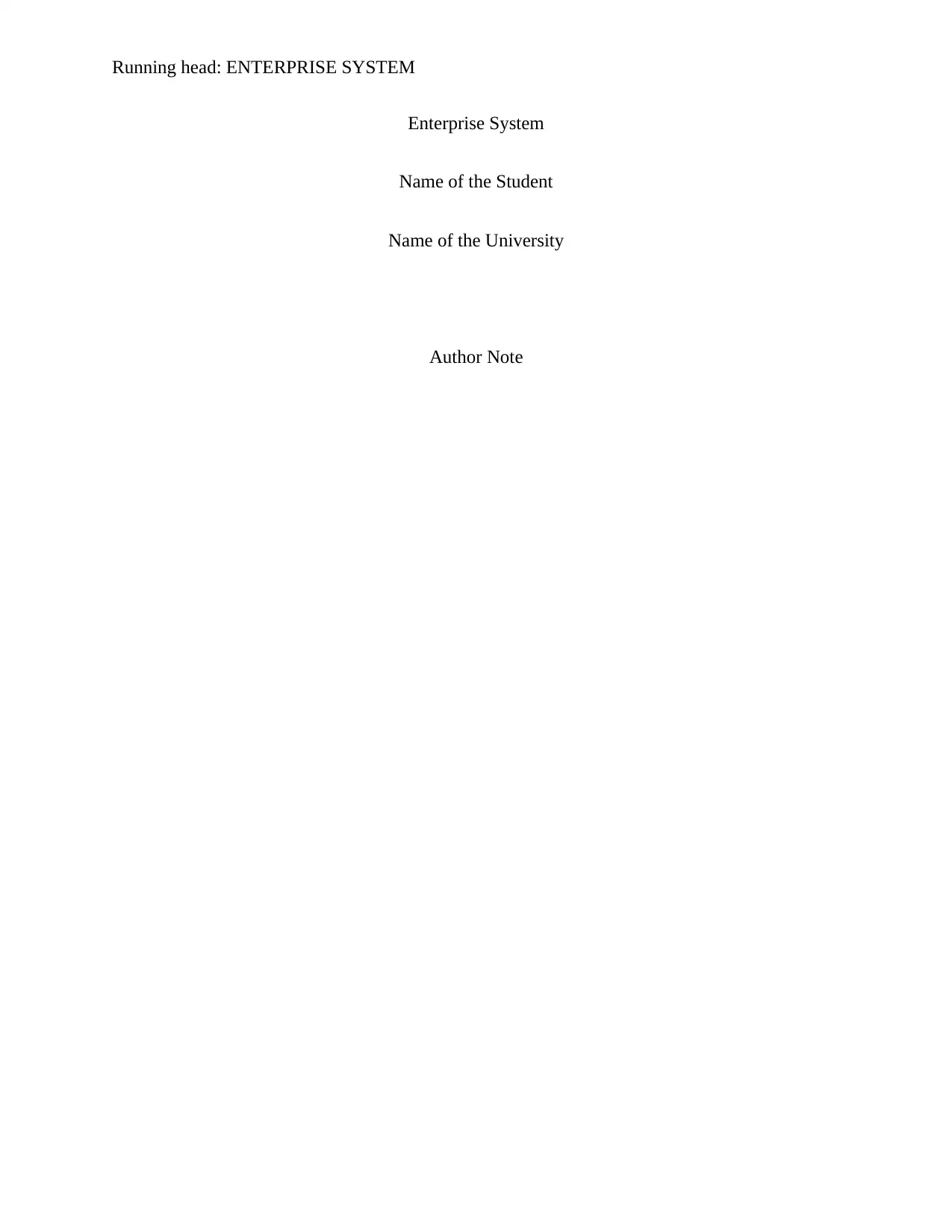
Running head: ENTERPRISE SYSTEM
Enterprise System
Name of the Student
Name of the University
Author Note
Enterprise System
Name of the Student
Name of the University
Author Note
Paraphrase This Document
Need a fresh take? Get an instant paraphrase of this document with our AI Paraphraser
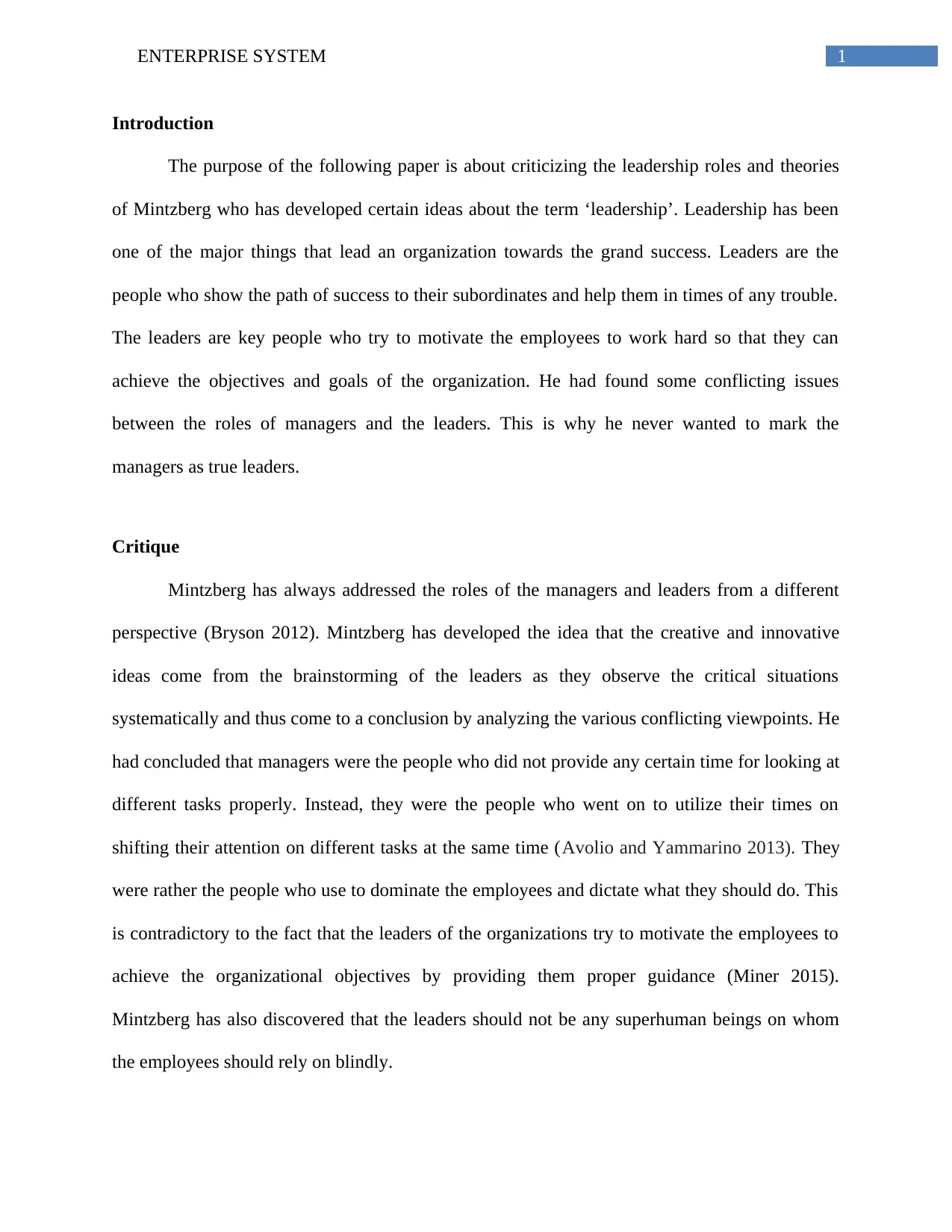
1ENTERPRISE SYSTEM
Introduction
The purpose of the following paper is about criticizing the leadership roles and theories
of Mintzberg who has developed certain ideas about the term ‘leadership’. Leadership has been
one of the major things that lead an organization towards the grand success. Leaders are the
people who show the path of success to their subordinates and help them in times of any trouble.
The leaders are key people who try to motivate the employees to work hard so that they can
achieve the objectives and goals of the organization. He had found some conflicting issues
between the roles of managers and the leaders. This is why he never wanted to mark the
managers as true leaders.
Critique
Mintzberg has always addressed the roles of the managers and leaders from a different
perspective (Bryson 2012). Mintzberg has developed the idea that the creative and innovative
ideas come from the brainstorming of the leaders as they observe the critical situations
systematically and thus come to a conclusion by analyzing the various conflicting viewpoints. He
had concluded that managers were the people who did not provide any certain time for looking at
different tasks properly. Instead, they were the people who went on to utilize their times on
shifting their attention on different tasks at the same time (Avolio and Yammarino 2013). They
were rather the people who use to dominate the employees and dictate what they should do. This
is contradictory to the fact that the leaders of the organizations try to motivate the employees to
achieve the organizational objectives by providing them proper guidance (Miner 2015).
Mintzberg has also discovered that the leaders should not be any superhuman beings on whom
the employees should rely on blindly.
Introduction
The purpose of the following paper is about criticizing the leadership roles and theories
of Mintzberg who has developed certain ideas about the term ‘leadership’. Leadership has been
one of the major things that lead an organization towards the grand success. Leaders are the
people who show the path of success to their subordinates and help them in times of any trouble.
The leaders are key people who try to motivate the employees to work hard so that they can
achieve the objectives and goals of the organization. He had found some conflicting issues
between the roles of managers and the leaders. This is why he never wanted to mark the
managers as true leaders.
Critique
Mintzberg has always addressed the roles of the managers and leaders from a different
perspective (Bryson 2012). Mintzberg has developed the idea that the creative and innovative
ideas come from the brainstorming of the leaders as they observe the critical situations
systematically and thus come to a conclusion by analyzing the various conflicting viewpoints. He
had concluded that managers were the people who did not provide any certain time for looking at
different tasks properly. Instead, they were the people who went on to utilize their times on
shifting their attention on different tasks at the same time (Avolio and Yammarino 2013). They
were rather the people who use to dominate the employees and dictate what they should do. This
is contradictory to the fact that the leaders of the organizations try to motivate the employees to
achieve the organizational objectives by providing them proper guidance (Miner 2015).
Mintzberg has also discovered that the leaders should not be any superhuman beings on whom
the employees should rely on blindly.
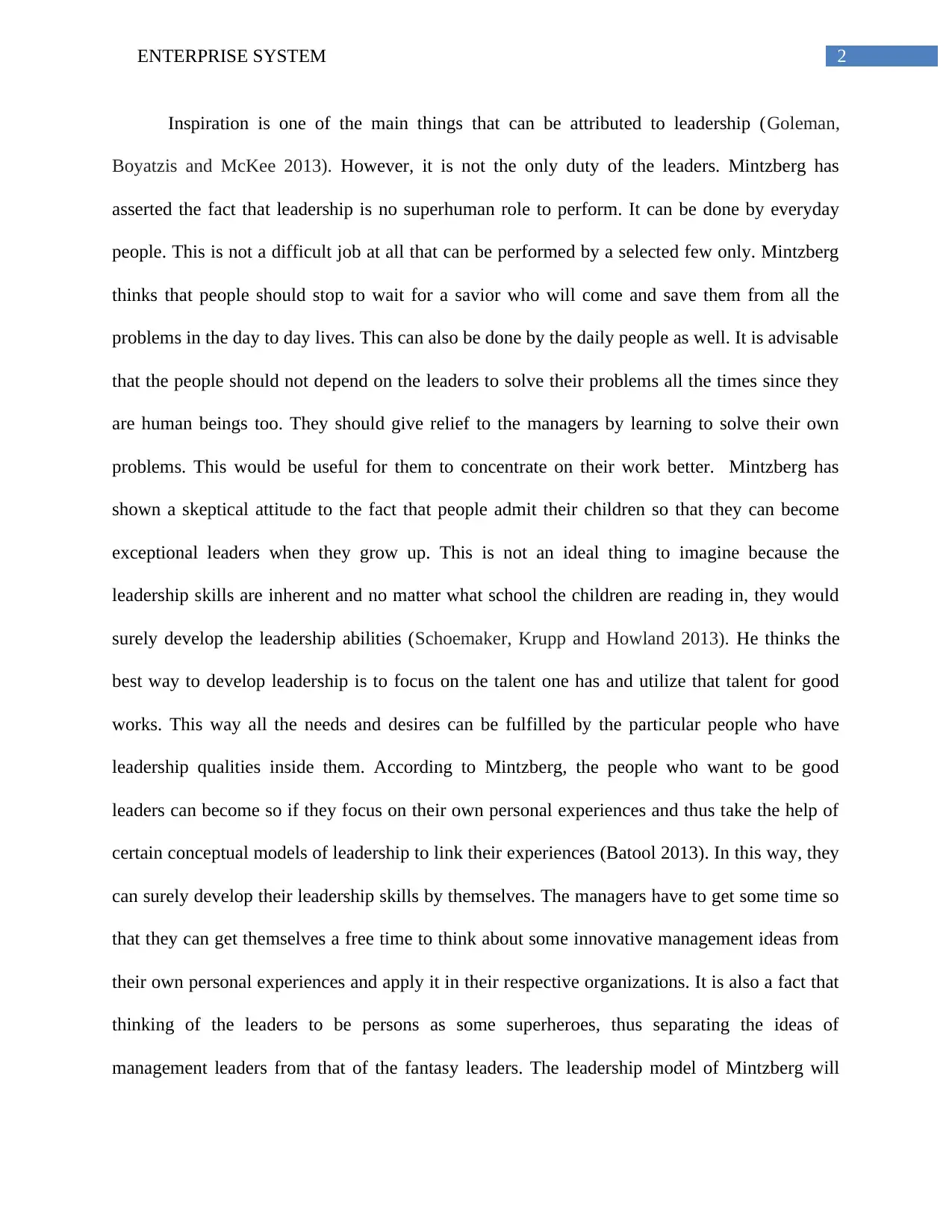
2ENTERPRISE SYSTEM
Inspiration is one of the main things that can be attributed to leadership (Goleman,
Boyatzis and McKee 2013). However, it is not the only duty of the leaders. Mintzberg has
asserted the fact that leadership is no superhuman role to perform. It can be done by everyday
people. This is not a difficult job at all that can be performed by a selected few only. Mintzberg
thinks that people should stop to wait for a savior who will come and save them from all the
problems in the day to day lives. This can also be done by the daily people as well. It is advisable
that the people should not depend on the leaders to solve their problems all the times since they
are human beings too. They should give relief to the managers by learning to solve their own
problems. This would be useful for them to concentrate on their work better. Mintzberg has
shown a skeptical attitude to the fact that people admit their children so that they can become
exceptional leaders when they grow up. This is not an ideal thing to imagine because the
leadership skills are inherent and no matter what school the children are reading in, they would
surely develop the leadership abilities (Schoemaker, Krupp and Howland 2013). He thinks the
best way to develop leadership is to focus on the talent one has and utilize that talent for good
works. This way all the needs and desires can be fulfilled by the particular people who have
leadership qualities inside them. According to Mintzberg, the people who want to be good
leaders can become so if they focus on their own personal experiences and thus take the help of
certain conceptual models of leadership to link their experiences (Batool 2013). In this way, they
can surely develop their leadership skills by themselves. The managers have to get some time so
that they can get themselves a free time to think about some innovative management ideas from
their own personal experiences and apply it in their respective organizations. It is also a fact that
thinking of the leaders to be persons as some superheroes, thus separating the ideas of
management leaders from that of the fantasy leaders. The leadership model of Mintzberg will
Inspiration is one of the main things that can be attributed to leadership (Goleman,
Boyatzis and McKee 2013). However, it is not the only duty of the leaders. Mintzberg has
asserted the fact that leadership is no superhuman role to perform. It can be done by everyday
people. This is not a difficult job at all that can be performed by a selected few only. Mintzberg
thinks that people should stop to wait for a savior who will come and save them from all the
problems in the day to day lives. This can also be done by the daily people as well. It is advisable
that the people should not depend on the leaders to solve their problems all the times since they
are human beings too. They should give relief to the managers by learning to solve their own
problems. This would be useful for them to concentrate on their work better. Mintzberg has
shown a skeptical attitude to the fact that people admit their children so that they can become
exceptional leaders when they grow up. This is not an ideal thing to imagine because the
leadership skills are inherent and no matter what school the children are reading in, they would
surely develop the leadership abilities (Schoemaker, Krupp and Howland 2013). He thinks the
best way to develop leadership is to focus on the talent one has and utilize that talent for good
works. This way all the needs and desires can be fulfilled by the particular people who have
leadership qualities inside them. According to Mintzberg, the people who want to be good
leaders can become so if they focus on their own personal experiences and thus take the help of
certain conceptual models of leadership to link their experiences (Batool 2013). In this way, they
can surely develop their leadership skills by themselves. The managers have to get some time so
that they can get themselves a free time to think about some innovative management ideas from
their own personal experiences and apply it in their respective organizations. It is also a fact that
thinking of the leaders to be persons as some superheroes, thus separating the ideas of
management leaders from that of the fantasy leaders. The leadership model of Mintzberg will
⊘ This is a preview!⊘
Do you want full access?
Subscribe today to unlock all pages.

Trusted by 1+ million students worldwide
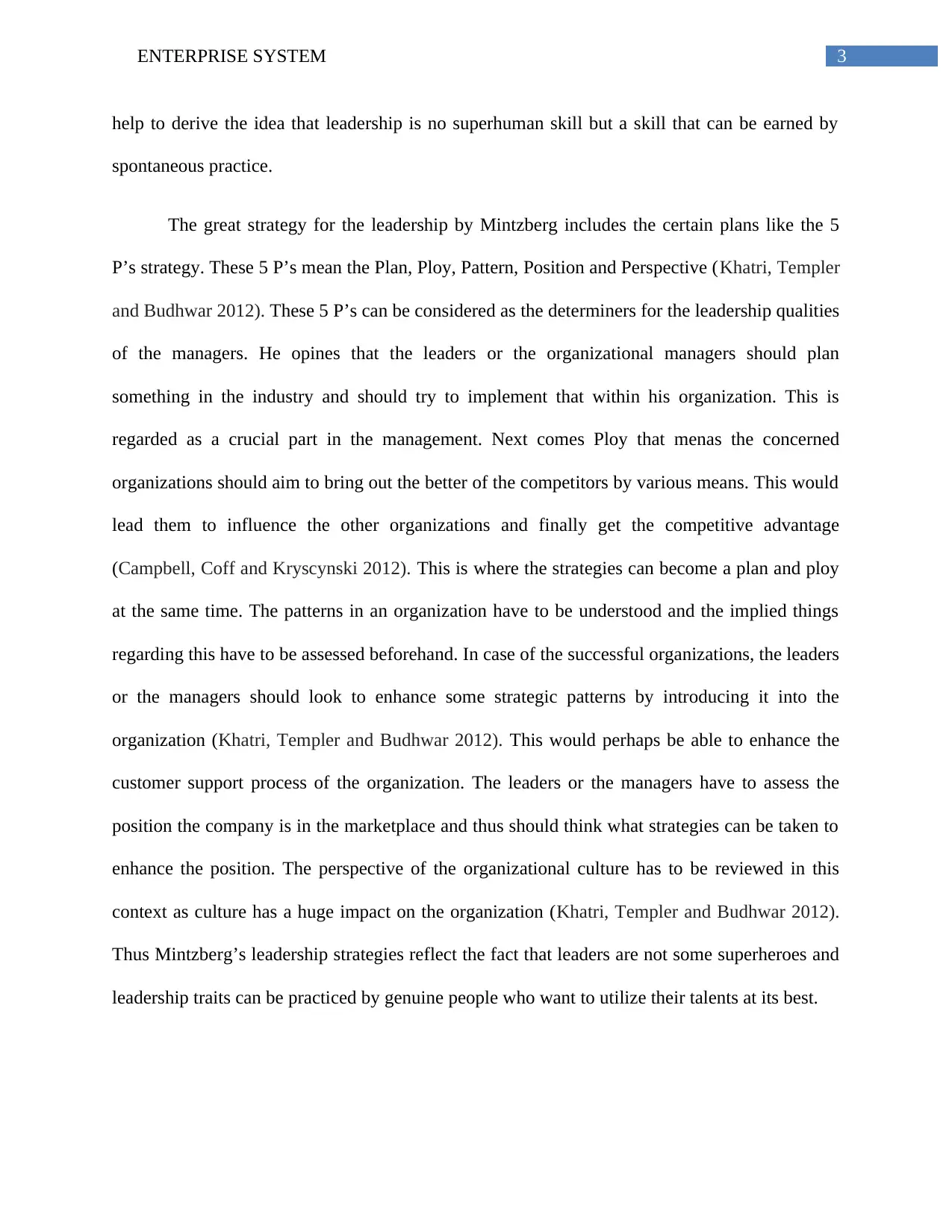
3ENTERPRISE SYSTEM
help to derive the idea that leadership is no superhuman skill but a skill that can be earned by
spontaneous practice.
The great strategy for the leadership by Mintzberg includes the certain plans like the 5
P’s strategy. These 5 P’s mean the Plan, Ploy, Pattern, Position and Perspective (Khatri, Templer
and Budhwar 2012). These 5 P’s can be considered as the determiners for the leadership qualities
of the managers. He opines that the leaders or the organizational managers should plan
something in the industry and should try to implement that within his organization. This is
regarded as a crucial part in the management. Next comes Ploy that menas the concerned
organizations should aim to bring out the better of the competitors by various means. This would
lead them to influence the other organizations and finally get the competitive advantage
(Campbell, Coff and Kryscynski 2012). This is where the strategies can become a plan and ploy
at the same time. The patterns in an organization have to be understood and the implied things
regarding this have to be assessed beforehand. In case of the successful organizations, the leaders
or the managers should look to enhance some strategic patterns by introducing it into the
organization (Khatri, Templer and Budhwar 2012). This would perhaps be able to enhance the
customer support process of the organization. The leaders or the managers have to assess the
position the company is in the marketplace and thus should think what strategies can be taken to
enhance the position. The perspective of the organizational culture has to be reviewed in this
context as culture has a huge impact on the organization (Khatri, Templer and Budhwar 2012).
Thus Mintzberg’s leadership strategies reflect the fact that leaders are not some superheroes and
leadership traits can be practiced by genuine people who want to utilize their talents at its best.
help to derive the idea that leadership is no superhuman skill but a skill that can be earned by
spontaneous practice.
The great strategy for the leadership by Mintzberg includes the certain plans like the 5
P’s strategy. These 5 P’s mean the Plan, Ploy, Pattern, Position and Perspective (Khatri, Templer
and Budhwar 2012). These 5 P’s can be considered as the determiners for the leadership qualities
of the managers. He opines that the leaders or the organizational managers should plan
something in the industry and should try to implement that within his organization. This is
regarded as a crucial part in the management. Next comes Ploy that menas the concerned
organizations should aim to bring out the better of the competitors by various means. This would
lead them to influence the other organizations and finally get the competitive advantage
(Campbell, Coff and Kryscynski 2012). This is where the strategies can become a plan and ploy
at the same time. The patterns in an organization have to be understood and the implied things
regarding this have to be assessed beforehand. In case of the successful organizations, the leaders
or the managers should look to enhance some strategic patterns by introducing it into the
organization (Khatri, Templer and Budhwar 2012). This would perhaps be able to enhance the
customer support process of the organization. The leaders or the managers have to assess the
position the company is in the marketplace and thus should think what strategies can be taken to
enhance the position. The perspective of the organizational culture has to be reviewed in this
context as culture has a huge impact on the organization (Khatri, Templer and Budhwar 2012).
Thus Mintzberg’s leadership strategies reflect the fact that leaders are not some superheroes and
leadership traits can be practiced by genuine people who want to utilize their talents at its best.
Paraphrase This Document
Need a fresh take? Get an instant paraphrase of this document with our AI Paraphraser
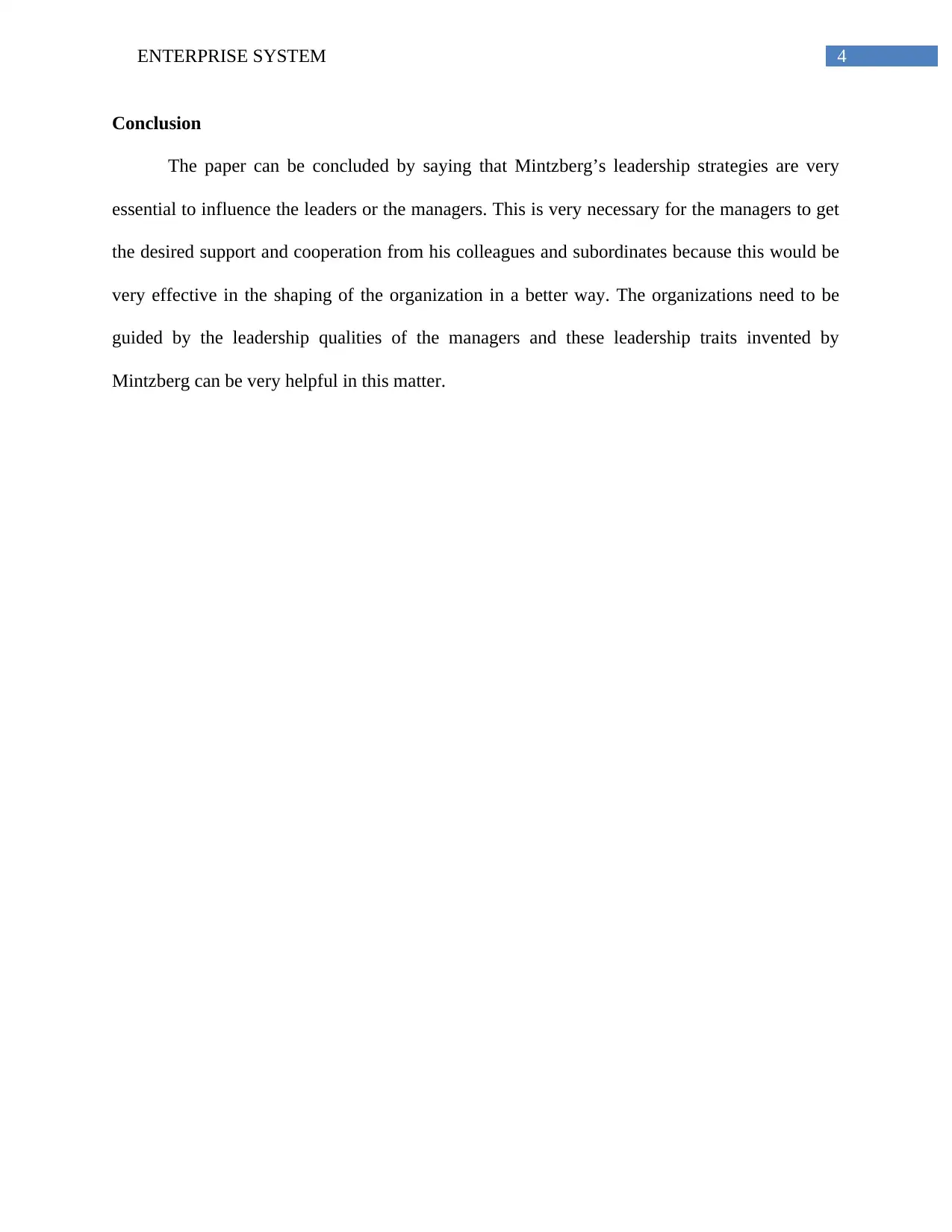
4ENTERPRISE SYSTEM
Conclusion
The paper can be concluded by saying that Mintzberg’s leadership strategies are very
essential to influence the leaders or the managers. This is very necessary for the managers to get
the desired support and cooperation from his colleagues and subordinates because this would be
very effective in the shaping of the organization in a better way. The organizations need to be
guided by the leadership qualities of the managers and these leadership traits invented by
Mintzberg can be very helpful in this matter.
Conclusion
The paper can be concluded by saying that Mintzberg’s leadership strategies are very
essential to influence the leaders or the managers. This is very necessary for the managers to get
the desired support and cooperation from his colleagues and subordinates because this would be
very effective in the shaping of the organization in a better way. The organizations need to be
guided by the leadership qualities of the managers and these leadership traits invented by
Mintzberg can be very helpful in this matter.
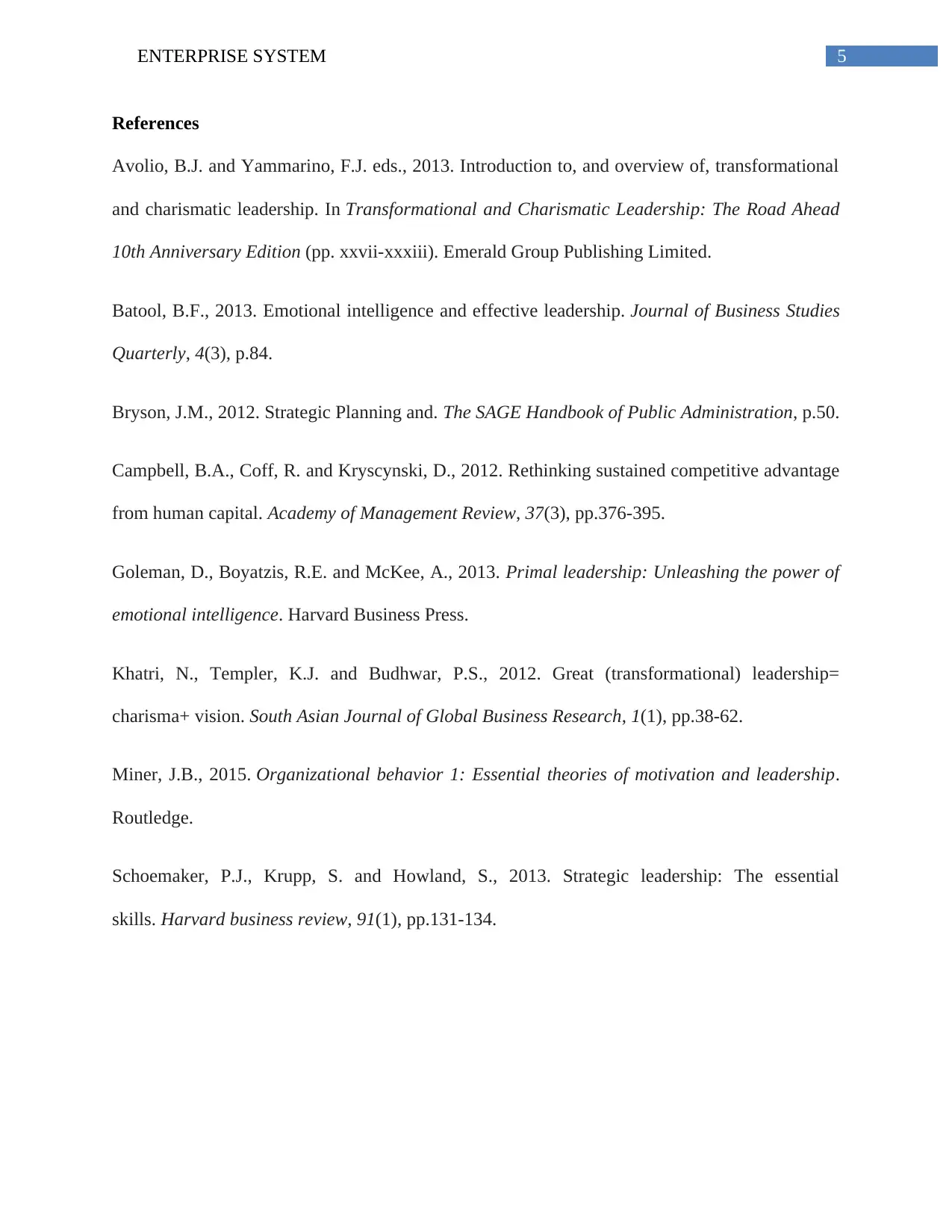
5ENTERPRISE SYSTEM
References
Avolio, B.J. and Yammarino, F.J. eds., 2013. Introduction to, and overview of, transformational
and charismatic leadership. In Transformational and Charismatic Leadership: The Road Ahead
10th Anniversary Edition (pp. xxvii-xxxiii). Emerald Group Publishing Limited.
Batool, B.F., 2013. Emotional intelligence and effective leadership. Journal of Business Studies
Quarterly, 4(3), p.84.
Bryson, J.M., 2012. Strategic Planning and. The SAGE Handbook of Public Administration, p.50.
Campbell, B.A., Coff, R. and Kryscynski, D., 2012. Rethinking sustained competitive advantage
from human capital. Academy of Management Review, 37(3), pp.376-395.
Goleman, D., Boyatzis, R.E. and McKee, A., 2013. Primal leadership: Unleashing the power of
emotional intelligence. Harvard Business Press.
Khatri, N., Templer, K.J. and Budhwar, P.S., 2012. Great (transformational) leadership=
charisma+ vision. South Asian Journal of Global Business Research, 1(1), pp.38-62.
Miner, J.B., 2015. Organizational behavior 1: Essential theories of motivation and leadership.
Routledge.
Schoemaker, P.J., Krupp, S. and Howland, S., 2013. Strategic leadership: The essential
skills. Harvard business review, 91(1), pp.131-134.
References
Avolio, B.J. and Yammarino, F.J. eds., 2013. Introduction to, and overview of, transformational
and charismatic leadership. In Transformational and Charismatic Leadership: The Road Ahead
10th Anniversary Edition (pp. xxvii-xxxiii). Emerald Group Publishing Limited.
Batool, B.F., 2013. Emotional intelligence and effective leadership. Journal of Business Studies
Quarterly, 4(3), p.84.
Bryson, J.M., 2012. Strategic Planning and. The SAGE Handbook of Public Administration, p.50.
Campbell, B.A., Coff, R. and Kryscynski, D., 2012. Rethinking sustained competitive advantage
from human capital. Academy of Management Review, 37(3), pp.376-395.
Goleman, D., Boyatzis, R.E. and McKee, A., 2013. Primal leadership: Unleashing the power of
emotional intelligence. Harvard Business Press.
Khatri, N., Templer, K.J. and Budhwar, P.S., 2012. Great (transformational) leadership=
charisma+ vision. South Asian Journal of Global Business Research, 1(1), pp.38-62.
Miner, J.B., 2015. Organizational behavior 1: Essential theories of motivation and leadership.
Routledge.
Schoemaker, P.J., Krupp, S. and Howland, S., 2013. Strategic leadership: The essential
skills. Harvard business review, 91(1), pp.131-134.
⊘ This is a preview!⊘
Do you want full access?
Subscribe today to unlock all pages.

Trusted by 1+ million students worldwide
1 out of 6
Related Documents
Your All-in-One AI-Powered Toolkit for Academic Success.
+13062052269
info@desklib.com
Available 24*7 on WhatsApp / Email
![[object Object]](/_next/static/media/star-bottom.7253800d.svg)
Unlock your academic potential
Copyright © 2020–2025 A2Z Services. All Rights Reserved. Developed and managed by ZUCOL.





